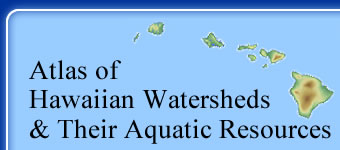
Introduction - Stream Animals: Native species
The unparalleled remoteness and isolation of the Hawaiian high islands are accountable for the reduced number of species and high degree of endemism among the species of indigenous animals and plants that occur there naturally. This fact is well illustrated by the animals that live in island streams. The entire native vertebrate fauna and larger invertebrates (macroinvertebrates) of most Hawaiian streams includes only five species of fishes, two species of mollusks (limpets), and two species of crustaceans (prawn and shrimp). All but one species (fish) occur only in Hawaii. Many marine species enter estuaries and the lower reaches of streams, but a total count of nine includes all native species limited to brackish and fresh water as adults.
Hawaii’s stream fishes belong to two families, the Gobiidae and Eleotridae, which are common throughout the islands of the Indo-Pacific in estuaries, streams, in near-shore habitats such as tidal pools and ponds, on sandy flats, and among coral reefs. Many species of eleotrids occur throughout the world in temperate and tropical seas and brackish lagoons and estuaries, and the gobiids, also widely distributed, comprise not only the largest family of fishes, but also the world’s largest family of vertebrates. Gobioid fishes (eleotrids and gobies collectively) in Hawaiian streams have their nearest relatives in the Western Pacific Ocean. The ancestors of the Hawaiian stream fishes were very likely those stream species with a protracted period as marine larvae capable of being transported over the long distance from the Western Pacific to Hawaii probably by Japan’s Kuroshio Current. The origin and dispersal to Hawaii by stream-dwelling macroinvertebrates may be similar to those of fishes, but interisland affinities and the marine phase of the life histories of the Hawaiian species of stream mollusks and crustaceans apparently have never been studied.
Stream fishes and macroinvertebrates are predictably distributed within and among streams. The eleotrid, Eleotris sandwicensis (‘o'opu ‘akupa) and goby Stenogobius hawaiiensis (‘o'opu naniha) are most common in estuaries and in the lower reaches of streams below the first waterfall of a meter or more. Awaous guamensis (‘o'opu nākea) and Sicyopterus stimpsoni (‘o’opu nōpili) occur in the middle reaches of streams, and Lentipes concolor (‘o’opu hi'ukole for males, ‘o’opu ‘alamo'o for females) usually occurs farther upstream beyond the instream range of the other fishes. The limpet Neritina vespertina (hapawai) is limited to the brackish water of estuaries, and the other limpet N. granosa (hīhīwai or wī) is most common in the lower and middle reaches of streams. The native prawn Macrobrachium grandimanus (‘ōpae ‘oeha'a) occurs in estuaries and in areas of lower stream reaches where current is reduced. Atyoida bisulcata (‘ōpae kuahiwi) can occur anywhere along the length of a stream, but these small atyid shrimp are most dense in the upper reaches of streams. Streams that slope gradually from the headwaters to an estuary are likely to have all nine species of aquatic animals. High-gradient streams that have no estuary may have only the upstream species (A. guamensis, S. stimpsoni, N. granosa, L. concolor, and A. bisulcata). Those streams that end in a waterfall that drops about 10 meters (ca. 30 ft.) directly onto the beach probably will have S. stimpsoni, L. concolor, and A. bisulcata, while those that drop 20 meters or more onto a beach are likely to have only L. concolor and A. bisulcata. The effect of stream morphology on the presence/absence of stream species is sufficiently predictable that it is usually possible to know what species are present and where they are located in a stream merely by examining a detailed map with contour intervals.